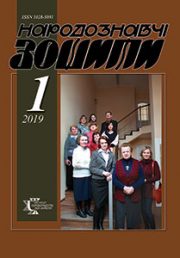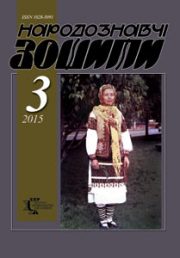The Ethnology Notebooks. 2021. # 1 (157), P. 157—162
УДК 37(477) (091) В. Девдюк
DOI https://doi.org/10.15407/nz2021.01.157
Yuri YUSYPCHUK
- Candidate of Art History, Associate Professor
- of the Department of Decorative and Applied Arts,
- Deputy Director of the Institute of Arts;
- Vasyl Stefanyk Precarpathian National University,
- 34-A, Academician Sakharov str., 76014, Ivano-Frankivsk, Ukraine,
- e-mail: yusupchuk@meta.ua
VASYL DEVDYUK’S TEACHING ACTIVITY AT VYZHNYTSIA SCHOOL
The purpose of the article: is to analyze the conditions and principles of the creation of a Hutsul school and woodworking of Vasyl Devdyuk, its creation and the latest traditions of culture, the typology of works of this art of the first half of the nineteenth Art on Hutsulshchyna.
It is Important to study the local tradition of the latest Hutsul treeworking, not only the stage of it’s development, but also taking into account all innovative “outbreaks” of ideas that went from folk masters. And relevance of the topic is the formation in Ukraine of the latest perception of the artistic heritage of the nation.
The object of research is the School of Vasyl Devdyuk and the traditions of Hutsul woodworking. The subject of the research is the historical and socio-cultural preconditions for the emergence of urban school and woodworking on Hutsulshchyna in the first half of the nineteenth century.
The source basis of the study became scientific, journalistic and artistic works on the chosen topic and analysis of artistic samples of urban and woodworking on the Hutsul region of the early twentieth century.
The research methods are chosen by the principle of systemicity, a method of historical reconstruction and a contextual method.
Hutsul artistic woodworking and brass making is known and popular in the art world. From the middle of the XIX century, under the influence of romantic writers and artists, the European intelligentsia began to take an active interest in folk culture. In the second half of the 19th century, wealthy tourists became in demand for Hutsul products made of wood, metal, horn, leather, fabric, and so on. Demand has generated a supply of products, not simple, but artistically more refined and colorful than ever before.
Hutsul masters introduced techniques in the artistic processing of wood, which at the beginning of the XX century grew into a new artistic tradition. Among the innovators was Vasyl Devdyuk from Old Kosіv.
The article analyzes the conditions and principles of creating a school of Hutsul brass and woodworking of Vasyl Devdyuk, its creation and the latest traditions of culture, the typology of works of this art of the first half of the nineteenth century in the Hutsul region.
Keywords: Vasyl Devdyuk, art of Hutsuls, brassmaking, artistic woodworking, wood carving, typology of works of Hutsul brassmaking.
REFERENCES
- Yusypchuk, Yu. (1999). Masters of Hutsul woodworking of the first half of the XIX century and Skriblyak’s innovation. Art Studies’99 (Pp. 153—166). Lviv [in Ukrainian].
- Shmagalo, R.T. (1995). Vyzhnytsky College of Decorative and Applied Arts. V. Skriblyak is 90 years old. Art and literary almanac. Shchivypadnyk (Issue 16) [in Ukrainian].
- Solomchenko, O. (1969). Folk talents of Prykarpattia. Kyiv [in Ukrainian].
- Budzan, A.F. (1960). Wood carving in the western regions of Ukraine. Kyiv [in Ukrainian].
- Seweryn, T. (1924). Hutsul book on a tree. Crafts, handicrafts and art, 1, 2 [in Polish].
- Shukhevich, V. (1997). Hutsul region: Reprint. kind. 1899. Verkhovyna [in Ukrainian].
- Nekrasova, M.A. (1983). Folk art as part of culture. Moscow: Image. Art [in Russian].
- Eutelberger, R. (1871). Austrian art industry and modern world situation. Vienna [in German].







